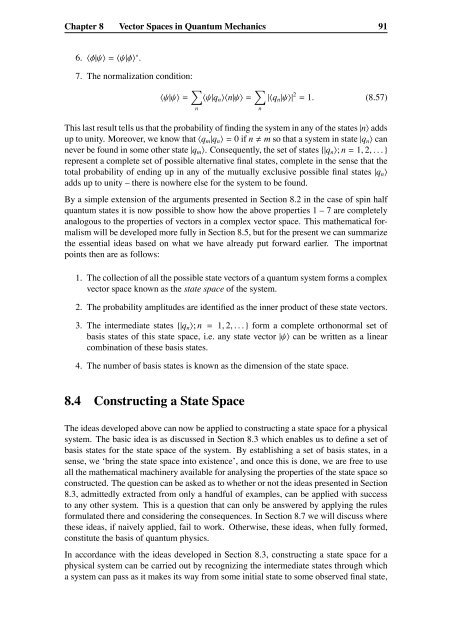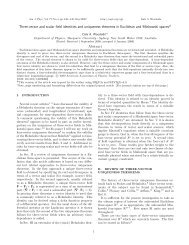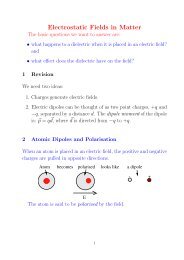Chapter 8 Vector Spaces in Quantum Mechanics
Chapter 8 Vector Spaces in Quantum Mechanics
Chapter 8 Vector Spaces in Quantum Mechanics
You also want an ePaper? Increase the reach of your titles
YUMPU automatically turns print PDFs into web optimized ePapers that Google loves.
<strong>Chapter</strong> 8 <strong>Vector</strong> <strong>Spaces</strong> <strong>in</strong> <strong>Quantum</strong> <strong>Mechanics</strong> 916. 〈φ|ψ〉 = 〈ψ|φ〉 ∗ .7. The normalization condition:∑∑〈ψ|ψ〉 = 〈ψ|q n 〉〈n|ψ〉 = |〈q n |ψ〉| 2 = 1. (8.57)nThis last result tells us that the probability of f<strong>in</strong>d<strong>in</strong>g the system <strong>in</strong> any of the states |n〉 addsup to unity. Moreover, we know that 〈q m |q n 〉 = 0 if n m so that a system <strong>in</strong> state |q n 〉 cannever be found <strong>in</strong> some other state |q m 〉. Consequently, the set of states {|q n 〉; n = 1, 2, . . . }represent a complete set of possible alternative f<strong>in</strong>al states, complete <strong>in</strong> the sense that thetotal probability of end<strong>in</strong>g up <strong>in</strong> any of the mutually exclusive possible f<strong>in</strong>al states |q n 〉adds up to unity – there is nowhere else for the system to be found.By a simple extension of the arguments presented <strong>in</strong> Section 8.2 <strong>in</strong> the case of sp<strong>in</strong> halfquantum states it is now possible to show how the above properties 1 – 7 are completelyanalogous to the properties of vectors <strong>in</strong> a complex vector space. This mathematical formalismwill be developed more fully <strong>in</strong> Section 8.5, but for the present we can summarizethe essential ideas based on what we have already put forward earlier. The importnatpo<strong>in</strong>ts then are as follows:1. The collection of all the possible state vectors of a quantum system forms a complexvector space known as the state space of the system.2. The probability amplitudes are identified as the <strong>in</strong>ner product of these state vectors.3. The <strong>in</strong>termediate states {|q n 〉; n = 1, 2, . . . } form a complete orthonormal set ofbasis states of this state space, i.e. any state vector |ψ〉 can be written as a l<strong>in</strong>earcomb<strong>in</strong>ation of these basis states.4. The number of basis states is known as the dimension of the state space.n8.4 Construct<strong>in</strong>g a State SpaceThe ideas developed above can now be applied to construct<strong>in</strong>g a state space for a physicalsystem. The basic idea is as discussed <strong>in</strong> Section 8.3 which enables us to def<strong>in</strong>e a set ofbasis states for the state space of the system. By establish<strong>in</strong>g a set of basis states, <strong>in</strong> asense, we ‘br<strong>in</strong>g the state space <strong>in</strong>to existence’, and once this is done, we are free to useall the mathematical mach<strong>in</strong>ery available for analys<strong>in</strong>g the properties of the state space soconstructed. The question can be asked as to whether or not the ideas presented <strong>in</strong> Section8.3, admittedly extracted from only a handful of examples, can be applied with successto any other system. This is a question that can only be answered by apply<strong>in</strong>g the rulesformulated there and consider<strong>in</strong>g the consequences. In Section 8.7 we will discuss wherethese ideas, if naively applied, fail to work. Otherwise, these ideas, when fully formed,constitute the basis of quantum physics.In accordance with the ideas developed <strong>in</strong> Section 8.3, construct<strong>in</strong>g a state space for aphysical system can be carried out by recogniz<strong>in</strong>g the <strong>in</strong>termediate states through whicha system can pass as it makes its way from some <strong>in</strong>itial state to some observed f<strong>in</strong>al state,
















